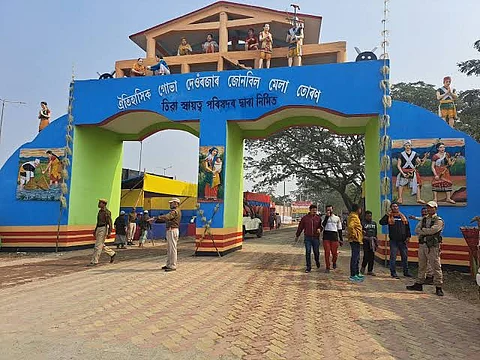
- Home
- Live Blog
- Breaking News
- Top Headlines
- Cities
- NE News
- Sentinel Media
- Sports
- Education
- Jobs

Himangshu Ranjan Bhuyan
(himangshur1989@gmail.com)
Jonbeel Mela is considered one of the most unique and historic festivals in Assam. It is alive today as the practice of yesterday. Every year, the mela is arranged near the crescent-shaped Jonbeel that is located some 5 kms from Jagiroad in the Morigaon district, which is at a distance of only 30 km from Guwahati. This is an age-old mela going on for so many centuries, which saved the practice of barter trade. It is a three-day festival, observed during the weekend of Magh Bihu in January, attracting people from all communities, particularly the Tiwa, Karbi, Khasi, and Jaintia tribes from the hills, who come to exchange goods with the plains people in a spirit of mutual cooperation and unity.
Historically, the Jonbeel Mela was begun in the 15th century by the Ahom kings, especially Gobha Raja, for the political discussions and the bonding of Assam and Meghalaya tribes. It is now a socio-cultural celebration with the concept of harmony and peaceful coexistence. The name Mela has come from the word “Jon,” meaning moon, and “Beel,” which means wetland, as inspired by the crescent-shaped water body next to the fairground.
The hill tribes come with forest products, herbs, spices, and fruits and barter for rice, fish, vegetables, and Assamese traditional pithas and sweets brought by the plains people. It is a rare sight in the present, defining the revival of the barter system. No currency transaction is involved in this exchange, stressing self-sufficiency and respect for one another. This revived barter trade captures the essence of the region while bringing back the memory of ancient economic practices that were flourishing before the dawn of monetary systems.
The mela begins with a community fishing event at Jonbeel Lake, where the same age-old fishing methods are now replicated into a beautiful spectacle. Before the activity of trading takes place, an Agni Puja ritual is carried out to invite the good fortune of humanity in the form of a message related to the religious purpose of the festival. Gobha Raja, however, is the traditional king of the people of Tiwa, and his festival will centre around him most importantly. On the last day, he collects his due taxes in the form of goods from his subjects, which is a custom representing historical governance and the symbolic relation between the ruler and his people. The king, along with his courtiers, who are attired in royal clothes, add to the grandeur of the mela in terms of history, as they preserve the relation between ancient customs and modern celebrations.
Jonbeel Mela is not merely an economic event but a deep cultural confluence of various tribal communities. The event presents their tradition, music, and dance, creating a rich experience. It’s a festival where tribal dance forms, traditional music, and folk performances bring together the tribes and create a festive atmosphere. The cockfights, exhibitions of traditional crafts, and the wooden furniture bazaar add more colours to the experience, and thousands of people come from all over Assam and neighbouring states to witness this spectacle.
The deeper significance of Jonbeel Mela is in its message of unity and peaceful coexistence. At a time when the cultural boundary might divide societies further, the festival reminds people that mutual respect has the power of shared heritage. Participation by the hill and the plain communities, despite their differences in lifestyle and language, makes it more crucial to have everyone together for this celebration. The festival brings together communities, thus creating goodwill and understanding, while the barter system symbolizes an exchange not only of goods but also of trust and cultural values.
Ecological sensitivity also incorporates the cultural values of Jonbeel Mela. A very strong impression regarding the cultural harmonisation of Jonbeel can be drawn through bamboo huts for dwellings, very simple types of decorations, fishing that is done by locals, and strictly sourced products that are taken into service during the whole fair. All such measures give prominence to the very principle of environmental conservation and prove this festival a perfect example in its kind towards eco-friendly functions.
This is a testament to the strength of indigenous cultural practices against modernization, as Jonbeel Mela has survived the centuries. As the world moves to digital economies and globalised markets, Jonbeel Mela survives on self-sufficiency and human touch. But, on the other hand, commercialisation pressures threaten the festival’s traditional character due to growing tourist attention. The challenge remains for the organisers and the participating communities to balance cultural preservation with modern accessibility.
Jonbeel Mela is very relevant in the modern world because it can evoke cultural pride and historical awareness. It provides a platform whereby the young generations will get reconnected to their heritage, understanding the importance of community bonds and cooperative living. The process of collection of taxes by Gobha Raja sets an ancient mode of governance focusing on the tribal societies and strictly calls for respect towards the traditional leadership structures.
Jonbeel Mela is a great cultural spectacle—a living museum of ancient traditions that blend history, economy, and social harmony. It is not only a festival but the very depth of how indigenous communities have preserved their identity, values, and relationships with nature and each other. At a time when the world is changing at a whirlwind pace with globalisation, this mela presents a rare chance to see how simplicity, cooperation, and pride in culture will be the highlights of the mela. This reminds us that the roots of a community, no matter how old, can still bloom and inspire, making Jonbeel Mela a celebration not just for Assam but for humanity at large.